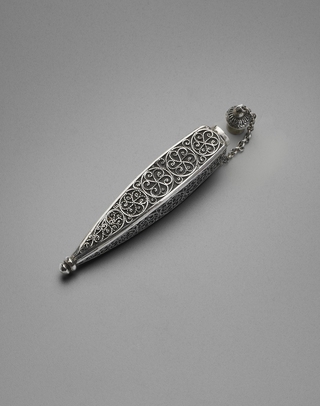Incense Pendant

Incense Pendant, late 20th Century, Morocco
Accession no. 2024.04.21
Yale University Art Gallery
This silver incense pendant is 4 ¼ inches long and has a square tube-like body that tapers to a point; it measures one inch by one inch in width and depth. It has a delicate and elaborate filigree braided design on all sides and in the cap. Four complete hexafoil rosettes decorate the thickest part of the bottle and as it tapers down a fifth rosette winds around the narrowing space. The incense pendant is a representative example of traditional Moroccan jewelry that highlights the importance of aroma and scents in Islamic customs and rituals.
In Islam, the sunnah, or the traditions and practices of the Prophet Muhammad, encourages the use of perfume and other aromatic substances like incense. The incense pendant is compact and can transport scent with the user, serving a quasi-religious purpose. The craft of precious decorated metal vessels is part of Morocco’s rich heritage and tradition. In the necklaces of the Berber people of Morocco, there are pendants/amulets, similar in shape to the incense pendant, with an opening for scented herbs which lend prophylactic power and healing properties. The hexafoil rosettes in the incense pendant, and the use of geometry in Islamic art, articulate a language that evokes the divine, which is strongly supported by Quranic descriptions of Paradise: a lush and divine garden.
Sources:
Canby, Sheila R. “The Scented World: Incense Burners and Perfume Containers from Spain to Central Asia.” Arts of Asia vol. 42 (2012): 121-129.
Draguet, Michel, and Nathalie De Merode. Berber Memories: Women and Jewellery in Morocco: Through the Gillion Crowet Collections. Mercatorfonds, 2021.
Jereb, James F. Arts & Crafts of Morocco. Chronicle Books (CA), 1996.